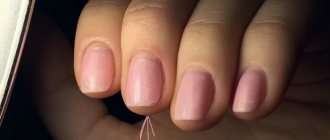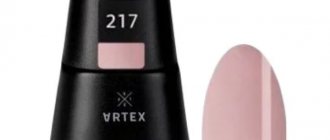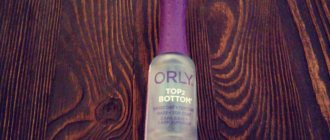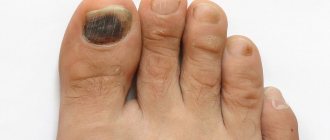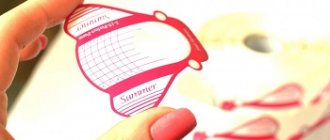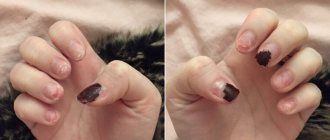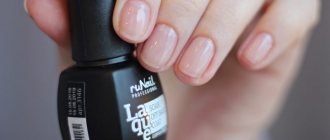Peculiarities
Nail plates in the shape of an “arch” look not only aesthetically pleasing, but also stylish. This extension is acceptable for any coating and different designs.
Professional nail specialists will help you choose a technique for extensions and create a manicure from acrylic or gel. You can use ready-made products to match the shape of your nails or perform the procedure directly on the plate, which is acceptable for those with brittle nails. This technology is not suitable for independent implementation, since there are many subtleties of the process.
- When building in an arched form, the resistance of natural and artificial plates to external influences is maintained.
- The procedure is done once a month. Considering that natural nails grow faster, you have to resort to correction.
- The condition for helium extensions is that a couple of days before the start of the procedure, you need to have a trimmed manicure.
- With the help of extended manicure, a beautiful and even shape of the nails is created.
- Nail plates become stronger.
- There is a guarantee of long wear of the artificial product until the first correction.
How to work with top forms
When using the upper forms, a template with an already formed nail is applied to the nail plate.
Step-by-step sequence of gel extensions on the upper forms:
- Preliminary preparation of nails is carried out.
- A nail is modeled on the inside of a sculpture gel stencil and the layer is partially polymerized in a UV lamp (20 sec) or LED (10 sec).
- A layer of base gel is applied to the nail plate to ensure adhesion to the artificial nail.
- The stencil form is pressed tightly in the desired position (without distortions) to the nail plate and fixed for 15-20 seconds.
- Using a pusher, excess gel mass is removed.
- The nail is placed under a lamp for final polymerization.
- The shape is carefully removed and the edge is adjusted with a nail file. The surface of the nail does not need correction, because... with this method it turns out perfectly smooth.
- A protective layer is applied.
This method is quite labor-intensive, but it is indispensable for repairing broken nails and correcting cracks and other serious defects.
Modern techniques and materials allow you to create a durable and beautiful manicure. One of these technologies includes gel nail extensions on forms. If you follow the step-by-step instructions, you can achieve an aesthetic and wearable manicure.
Infections after nail extensions
When using non-sterile tools for nail extensions, various types of infections may appear that violate the natural integrity of the natural nail. When the gel or acrylic layer on the nail is damaged, a small gap (air gap) appears, which is an ideal environment for the proliferation of pathogenic fungi and microorganisms. If the damaged nail is not freed from the artificial layer, this can lead to negative consequences.
gribok-nogtej-pod-gelevim-nogtem
It is worth remembering that even after high-quality extensions, the nail plate weakens significantly, which increases the risk of infection with many fungi and infections. If you find a damaged nail, it is recommended to go to a salon or remove the artificial layer yourself using a file. Treatment of fungal infections takes a fairly long period of time, which averages 6 months. If you do not consult a doctor in a timely manner, there is a high probability of losing your own nail and damaging the soft tissues of the hands. Manicurists and doctors advise constantly monitoring changes in the color and structure of the nail plate.
Risks of nail extensions
Nail extensions are not always safe for health. If you have health problems, consult your doctor and manicurist before the procedure.
It is not recommended to do nail extensions for pregnant women, cancer patients, people who have allergies, hormonal disorders, liver and kidney diseases. People who are taking antibiotics are also advised to hold off on extensions. Those who have any problems with their nails (pain, bacteria or viruses on the surface) should not undergo a similar procedure. Extensions are best done on healthy nails.
Care during treatment
Until a new nail grows after stripping and its connection with the nail bed is restored, gentle care will be required.
It is forbidden:
- apply any irritating substances to the nail of the affected finger;
- paint your nails with varnish or try to disguise the defect with gel polish;
- wash dishes, use household detergents without gloves;
- use sharp instruments when performing a pedicure or manicure.
Take care of the health of your nails! Visit a podiatrist periodically to detect violations in a timely manner. To treat onycholysis in Moscow, ingrown toenails, fight against onychomycosis, calluses and other problems, contact the Eva Korneeva Podology Center for professional help from specialists with more than 10 years of experience.
Make an appointment by phone.
Disadvantages of gel extensions
We already know how long gel nail extensions last. This is their huge advantage. But it's time to mention the shortcomings. Compared to acrylic coating, gel is more brittle and fragile. Even if an acrylic nail can be easily corrected or simply repaired, then if the gel plate breaks this issue disappears by itself, because it cannot be repaired. The broken nail will simply need to be removed and a new one made. The gel also cannot withstand very sudden changes in temperature conditions; it instantly begins to crack. Popularly, gel tip extensions are called reinforced concrete, which means it will be very difficult to remove such luxury. Only the filing procedure will help - long, tedious, and very careful so as not to damage the natural nail.
Technology and necessary tools
It is best to have your nails strengthened with acrylic at a professional salon. The master will tell you in detail about the coating technology itself and prepare your hands for the procedure. Acrylic hardens quickly, so the process itself takes little time. If you wish, you can perform this procedure at home. And we will tell you how to cover your nails with acrylic yourself. First you need to buy special products. Choose high-quality proven materials, because the condition of your nails will depend on this. You will need:
- degreaser;
- acrylic liquid;
- tassels;
- manicure set (orange stick, files, brush, etc.)
Coverage step-by-step guide
Wash your hands with soap. You can take a relaxing bath. Then do a regular hygienic manicure: give your nails the desired shape, polish them, remove all dust from the nail plate with a brush and push back the cuticle. In the process of strengthening nails with acrylic, the cuticle is not removed, it is only pushed back with an orange stick. Degrease your nails with a special product. If it is not available, this can be done with alcohol. Dip the brush into the acrylic liquid and gently apply it to the nail plate, avoiding the cuticle.
It is important that the acrylic is applied in an even, thin layer. After a couple of seconds, apply a second coat. It should also be fairly thin and even. After a couple of minutes, when the acrylic coating has completely dried, use a sanding file to remove any unevenness from the nail. Apply special oil to the cuticles.
The acrylic coating is ready. Assess the condition of your nails before and after the procedure. Now your nails look shiny, well-groomed and healthy. The acrylic coating can be removed using a special liquid. Soak a cotton pad in the remover, apply to the nail, then wrap your fingers in foil for 10 minutes. Then carefully remove the coating with an orange stick.
There is another option for the procedure with acrylic - strengthening with acrylic powder. You can also buy it in a specialty store or order it online. The method of strengthening with powder is similar to the process of applying acrylic coating. Complete the first two points, that is, get a manicure and degrease the nail plate. Then dip the brush into acrylic liquid and squeeze well. Next, dip the tip of the brush into acrylic powder. A small ball should form on it. Apply this ball to your nail. While the acrylic is still wet, use a brush to stretch it over the entire surface of the nail. You can apply any color of varnish on top, decorate your manicure with designs, rhinestones, etc. For examples of spectacular manicure, see the photo.

Nail extensions - the basis for creative nail design
Nail extension is a salon procedure that is performed to correct their shape and length. For these purposes, a special modeling material is used, which, when dried, forms a durable coating that is resistant to mechanical damage. Without subsequent correction, nail extensions last no more than 1 month.
Types and techniques of nail extensions. Stages of the procedure
Nail extensions are a fashionable image procedure that is performed to quickly increase their length and correct their shape. For this, masters use modeling materials (sculpting gel for nail extensions, acrylic powder, silk ribbon) and special stencils.
Depending on the client’s wishes, nails can be given an extreme shape and the length can be increased by a maximum of 3.3 cm.
Extension solves the problem of short, asymmetrical and improperly growing nails, and also makes it possible to create the basis for a beautiful manicure art design.
Toenail extensions are used if the condition of the natural plates does not allow the client to get a full pedicure. Basically, the master works not on correcting their length, but on restoring their natural shape. The procedure is relevant if, as a result of an injury to the finger, the nail is severely damaged and its growth is impaired.
Depending on the material used, the following types of nail extensions are distinguished:
- Gel extensions. The procedure uses a liquid transparent gel - a hypoallergenic product that forms a durable and airtight coating. Its advantages are beauty, functionality and safety (low risk of fungal infection).
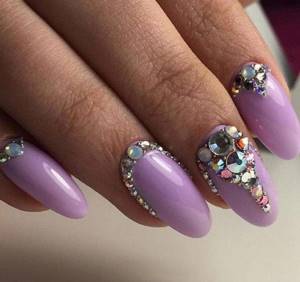
- Acrylic extensions . It is done using a combination of a special liquid and acrylic powder. The advantages of this method are high strength, durability and low risk of injury to the nails when removing the material. Disadvantages - increased toxicity, unpleasant odor and risk of allergic reactions
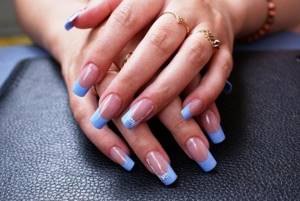
- Silk. The master glues a thin strip of fabric to the edge of the nail, which is covered with modeling gel. Next, using a nail file, he adjusts the shape and length. Silk extensions are not very popular due to the fragility of the modeling material. But this express technology is used today for the restoration of broken nails.

Which extension is considered the best?
The determining factor in choosing a modeling material is the individual characteristics of the client (susceptibility to allergic reactions, initial condition of the nail plates). Today, in the review rating, preference is given to the gel.
Nail extension methods
- For tips. A plastic or silicone mold is glued to the natural plate, which is then filed, polished and coated with a transparent coating. There is an opinion that inexperienced nail technicians choose nail extensions using tips because this method is easier. The disadvantage of the technology is increased injury during the material removal process. Reviews on forums indicate that nail extensions using tips are not the best procedure for high-quality nail design.
- On the forms. Disposable paper stickers with markings to model the length are attached to the client's nails. The material is applied using a brush, and after drying it in an ultraviolet lamp, the stencil is carefully removed. The advantage of molded nail extensions is the minimum damage to the natural plate when removing the modeling material.
The following video will demonstrate how regular nail extensions on the form take place:
The duration of the procedure is from 2.5 to 3 hours.
At what age can extensions be performed?
The procedure is not recommended for children under 17 years of age. Unstable hormonal levels during puberty will not bring the desired result, and nails may fall off even after a week. However, in some salons it is allowed to carry out extensions from the age of 14 - subject to parental consent.
Mistakes of incompetent nail technicians and treatment of problem nails
Before carrying out extensions at a professional level, the master must complete at least one training course, which lasts about a month. It also takes a lot of time to develop practical skills - mastering various techniques, working with problem nails, etc.
For beginning professionals who are still building their portfolio, this service is provided at a low price. But the quality of the result may be the same as in the next photo.
Let's consider the negative consequences that occur as a result of contacting an incompetent technician, and give recommendations for eliminating them.
- Allergy to components of extension materials. Characteristic symptoms: fingers become swollen and itchy, the skin of the hands dries out and turns red. The way out is to use antihistamines and ointments. The consumption of fried and spicy foods, as well as citrus fruits, is temporarily prohibited: such products make it difficult to treat allergies.
- Fungus is a common phenomenon, which is identified by characteristic yellow spots on the nail plates. Usually the infection is discovered after the extension material is removed. The cause of fungal infection is insufficient disinfection of working tools or weakened immunity of the client. The solution is to urgently contact a dermatologist who will prescribe medications.
Mechanical damage, fragility of natural nail plates. Most often this is the result of aggressive cutting of the extension material. When removing gel or acrylic, the “native” nails are often affected, which after the procedure become thin and slowly recover. Often their rehabilitation takes more than 1 month.
Extensions at home: is it worth it?
You can always call a nail service specialist to your home or carry out the procedure yourself. It won’t cost you a lot: for extensions you need to purchase special tools (from nail files to an ultraviolet lamp for drying gel polish) and materials (from base to modeling material and decorative elements). In addition, most of the purchased consumables will be wasted until you learn the basics of the procedure. Is it then worth spending funds without much benefit? If you are really interested in learning the basics of nail art, sign up for a special course where the entire learning process takes place under the guidance of experienced teachers.
Tips for home care
To ensure that your nail extensions serve you for a long time, follow these rules:
- Do all housework with rubber gloves. This is especially true when the skin of your hands comes into contact with household chemicals.
- Use cuticle oil. This product will help strengthen the nail plate and even replace hand cream.
- Do not use your fingernails as a tool for opening bottles or canned goods. When typing text, try not to hit the keys with them, but transfer the entire load to the pads of your fingers.
- Avoid sudden temperature changes. Washing your hands with very hot water and ignoring gloves in winter will shorten the life of your extensions. Sauna, bathhouse and solarium negatively affect the quality of manicure.
- Do not attempt to repair a broken nail yourself. For this purpose, there is a correction procedure using fiber (synthetic fiber). For an experienced master, repairing one nail will not take much time, and there will be no traces of correction left on the plate.
- Do not use a highly abrasive file. The optimal level of its hardness is no more than 150 grit.
- Do not remove the decorative coating with a product containing acetone: this aggressive component is harmful to extended nails.
Important ! You should not wash your hands for the first two hours after the procedure. Moisture on the nail plate negatively affects the durability of the manicure.
Correction process
After 3-4 weeks, the client’s nails grow back, and the border between the natural plate and the extended material becomes noticeable. To restore the neat appearance of the manicure, correction is necessary. Another reason to carry out such a procedure is cracks, chips or detachments of the modeling material.
During the process, the client’s hands are treated with an antiseptic, and then the modeling material is cut off with a milling cutter or nail file. Next, the nail plates are treated with a degreasing agent, and after it dries, the extension agent is applied again.
In general, the procedure lasts 1.5-2 hours.
Methods for removing extension material
Gel technique
First of all, the master adjusts the length of the nails by cutting them with special clippers. Next, the layers of gel are cut off with a router or a hard file. In this case, the specialist leaves a thin layer of modeling material so as not to damage the nail plate.
Afterwards, using a milling cutter, the shape of the nails is corrected and the cuticle is removed. Next, the nail plate is polished with a buff and covered with a healing coating. The final stage is applying nourishing oil to the cuticle.
Technique for acrylic
After trimming the edges, applications of cotton pads soaked in nail polish remover are applied to the nails. To ensure a tight seal, special plastic caps are put on the fingers (another option is to wrap them in foil). After 40 minutes, the softened material is removed with a pusher.
Next, the master will correct the shape of the nails, cleanse the skin of the hands and treat it with a nourishing cream.
Is it possible to remove extensions at home?
Today, enough master classes have been published on the Internet for removing modeling material yourself. It should be remembered: nails are injured precisely during the process of removing it, so the slightest carelessness can seriously harm them.
How long does recovery take?
Rehabilitation after removal of the extensions lasts at least 2 weeks. During this time, nails should come into contact with water as little as possible, so housework should be done exclusively with rubber gloves. It is not recommended to do a classic manicure using baths.
The protective agent “Smart Enamel” and the use of vitamin complexes with calcium and vitamins A and E will help strengthen your nails.
Contraindications and restrictions
To avoid unpleasant consequences, consider the following contraindications:
- dermatological diseases and fungal infections;
- diabetes mellitus, diseases of the cardiovascular system;
- taking antibiotics, conducting a course of chemotherapy;
- endocrine disorders.
Why do prohibitions apply to the above-mentioned diagnoses? The procedure will not harm your body, but hormonal imbalances or weakened immunity will minimize the service life of the extension. In such cases, nails are more likely to peel off and break.
Is it possible to get nail extensions while pregnant?
The procedure itself is not dangerous for the expectant mother and her child, but doctors still do not recommend performing it before birth. Due to unstable hormonal levels, the extensions will not last long.
Important! Extensions should not be carried out if the nail plates are seriously damaged. Otherwise, their condition will worsen when the modeling material is subsequently removed.
Alternative options: gel polish, biogel and others
For those who want to strengthen their nails without extensions, nail design centers will offer more affordable options:
- strengthening with biogel . This product differs from regular extension gel in its composition. The absence of carcinogenic and allergenic components makes it as safe as possible. Biogel is used both instead of an independent coating and as a base for decorative varnish. Its purpose is to stimulate growth and strengthen natural nails.
- gel polish . This coating, thick in consistency, is applied to the polished nail plate in several layers and dried in an ultraviolet lamp. When dry, it forms a durable protective layer that lasts 2-3 weeks without peeling or cracking. However, if the client is not satisfied with the shape of his nails, gel polish will not replace the extension procedure: it serves only as a decorative coating.
Conclusion. Pros and cons of extensions
Let’s summarize and consider once again the positive and negative aspects of this procedure.
Advantages:
- professional extensions help to lengthen nails without extra effort, as well as change their shape;
- with the help of this service, the basis is created for any artistic design of manicure (complex painting, “aquarium” design, art French, etc.);
- with careful handling of nails, the extension will last up to 4 weeks, and with timely correction - up to several months;
- It is possible to carry out the procedure at home by inviting a specialist to come to you.
Photos taken before and after the procedure will demonstrate how the appearance of your nails can change.
Flaws:
- high price of the service;
- removing extension material greatly weakens natural nails;
- There is a risk of fungal infection or allergic reaction.
The result of turning to an inexperienced nail technician can be a sloppy shape of the nails, their fragility and peeling of the material.
Nail extensions are one of the most popular services in the beauty industry, which every woman has used at least once in her life. What is your personal experience with nail modeling? We are waiting for comments from readers on the blog and Barb.ua communities on social networks.
Do you want to make an appointment for nail extensions? When choosing a specialist, study customer reviews and sign up for a preliminary consultation. The Barb.ua portal presents a directory of nail service specialists from Nikolaev, Kyiv, Zaporozhye and other cities.
Strengthening with modeling materials
The modeling material for the nail can be gel or acrylic. In what cases do you resort to strengthening a natural nail? If you like the thickness and shape of the nail, but are not satisfied with the length, then it is recommended to strengthen the plate. This allows you to overcome the critical length when your nails break.
The natural nail plate is covered with a thin layer of acrylic or gel, slightly filed, sanded a little, polished, and then varnished. After two weeks you can make a correction.
However, strengthened claws do not have the same strength as extended ones, but are much stronger than natural ones. The procedure for strengthening with gel and acrylic is done as a full-fledged extension, the only difference is that the thickness of the material is less.
Nails that are strengthened with synthetic material do not change their properties. They will be stronger as long as they are covered with gel or acrylic. This material does not perform any therapeutic function; it simply mechanically makes your plate stable and elastic, helping it not to break. However, as soon as this artificial material is removed, the nail will return to its original state.
What to do if your nails are peeling off the gel
If your health is in order, then you should change your manicurist, or choose material from a different company. For girls who want to do their own manicure, it is advisable to take training courses, and then write out a reminder for yourself with all the stages of work. By updating your manicure once a month, you may forget some details. The main thing is to maintain sterility and monitor the instrument.
If it’s a matter of how you feel, then you should immediately go and see a doctor. Before this, the gel must be removed. It is better if a master does this, carefully preserving the native nail. The technician needs to be warned about the problem, because the fungus is transmitted through hands. If you are allergic to the material, then it is useful for the master to know about such a dangerous reaction in the client.
Mistakes when working with acrylic
Working with materials
The master uses two jars - one with liquid monomer, the other with powder. The products must be from the same manufacturer, the same line - the design of such packages is usually the same. This is a guarantee that the chemical reaction will go well.
There are successful combinations of products from different brands, but then the specialist must test them in advance - check how he tested the reaction.
Posts too much material
“The more, the better it lasts” is a myth. If you make the free edge thick, it will overweight and break. If you overdo it near the cuticle, the coating will peel off.
The artist does not wipe the brush after each application.
The brush should be sharp, elastic, and keep its shape. When a master forgets to wipe the instrument, the remaining product inside the pile polymerizes. The brush will lose its shape and stop working accurately.
Treatment of onycholysis
Treatment should be comprehensive, especially for advanced cases. First, the doctor conducts an examination and the necessary examinations to determine the causes and contributing factors in the development of the pathology.
Among the means and methods of general influence, physiotherapeutic procedures, massage, probiotics, and angioprotectors are used. In addition, yeast extract, amino acid and vitamin-mineral complexes for oral administration are recommended, containing:
- vitamins of group “B”, stimulating metabolic processes, improving the function of peripheral nerves, etc.;
- antioxidant complex in the form of vitamins “A”, “E” and “C”, beta-carotene, which stimulates regeneration processes;
- macro- and microelements, especially with a high content of calcium, sulfur, zinc, copper and iron.
Local treatment at home consists of cutting off a section of the nail at its edge. Solcoseryl in the form of an ointment or gel helps to get rid of onycholysis. This drug, which improves blood circulation in tissues, has angio- and cytoprotective, antihypoxic, membrane-stabilizing and regenerative properties.
In the presence of a fungal infection, antimycotic drugs Mikospor, Lotseril, Ketonazole, Intraconazole, Batrafen are used topically. But the most effective (in the presence of a fungal infection) is the treatment of onycholysis with Exoderil, which in the form of a solution or cream is applied to the affected area and surrounding areas twice a day. The duration of therapy with this drug depends on the speed of recovery of the nail plate. The maximum course of treatment for hands is 6 months, for legs - from six months to 1 year. If the course is persistent, it is necessary to use antifungal agents not only locally, but also systemically.
Other emulsions and ointments are also used for onycholysis. Thus, for the purpose of prevention or in the presence of a bacterial (streptococcal and/or staphylococcal infection), synthomycin emulsion or heliomycin ointment is most often used, which are applied to the bed at the site of nail detachment and to the affected areas of soft tissue up to twice a day. Levomikol and Vishnevsky ointment, containing castor oil, birch tar and xeroform, have good antiseptic and regenerating properties.
Nail treatment
The doctor should tell you how to cure plates affected by fungus. If 1-2 nails are affected, it is enough to use local preparations. Most often, a specialist can prescribe Levorin, Triderm, Exoderil ointments. When local treatment does not overcome the disease, it is in an advanced form, or the fungus has penetrated into the nail growth area, Nystatin or Diflucan tablets are included in the treatment regimen.
In parallel, you can carry out treatment with folk remedies:
- Before going to bed, lubricate the plates with iodine, and wipe them with a 3% hydrogen peroxide solution in the morning. Then, soak gauze in penicillin and wrap it around the affected nail;
- pass a few cloves of garlic through a press. Add 5 milliliters of sunflower oil to the pulp. Lubricate the damaged surface;
- make a weak solution of potassium permanganate, steam your fingers a little. Apply onion or hot pepper juice to the plates.
If you have a question about how to treat mold, it is also better to contact a specialist. Ointments “Loceryl”, “Lamisil” and “Batrafen” are considered effective.
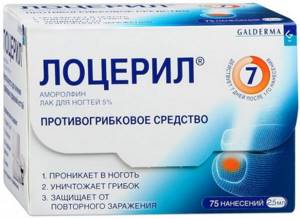
Therapy can be supplemented with popular traditional medicine:
- steam the handles in a warm soapy solution, then lubricate them with pharmaceutical birch tar;
- Dissolve 3 grams of baking soda in 250 milliliters of warm water. Lubricate your nails. After drying, treat the plates with celandine oil.
Advice. During treatment, avoid any manipulation of your nails. Only medical procedures are permitted.
Modeling using extensions
An artificial nail is not just covered with gel or acrylic, but an artificial one of the correct architecture and corresponding to certain parameters, which ensures the duration of the manicure. Extended claws are gaining great popularity today. However, it must be remembered that any innovation will have both advantages and disadvantages.
First you need to decide on the material for a piece nail, finding out all the pros and cons of acrylic and gel.
Gel is a less allergenic raw material. Under such material the nail feels more comfortable, but it cannot be restored if damaged. After damage, gel extension plates must be completely removed and a new one added. Therefore, manicurists give preference to acrylic, which hardens easily without the use of additional equipment, and removing nails extended using this technique is easier.
Forms for extensions
Forms for extensions are templates or stands that are used for laying out artificial nails with gel/acrylic. With the help of them it is very convenient to model long and even nails.
Forms for extensions come in two types:
Soft – disposable forms. Made from paper and plastic material.
Solid – reusable forms. Made from metal or durable plastic.
Care for gel nails
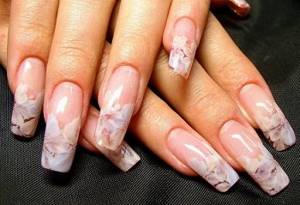
Extended nails need care
In order for a beautiful manicure to last for a long time, you need to take proper care of your nails. Masks and creams should be regularly applied to the cuticle, and it is better to avoid baths. It is forbidden to knock your nails on hard surfaces or click them; in the first couple of days you should not work at the computer for a long time and go to the bathhouse or sauna.
All housework should be done with gloves. You are not allowed to file your nails or change the design yourself. Correction of nail plates is best done no later than after 21 days.
Thus, gel peeling often occurs not only due to the fault of the master due to non-compliance with extension technology and poor materials, but also due to the negligence of the client himself. To wear a manicure for a long time, you should familiarize yourself with the intricacies of the procedure in advance and strictly follow the rules for caring for extended nails.
Stages of nail extension with single-phase gel on forms
Due to its ease of use, single-phase gel is optimal for those who are just learning the art of nail extensions. Beginners should build each finger separately.
After developing practical skills, it is important to follow the order of extensions: first, 4 nails (except the thumb) of one hand, then 4 nails of the other, last of all, the nails on the thumbs are processed - otherwise the gel will drain from them due to their angled location.
Extension step by step with gel on forms:
- Preliminary preparation of nails:
- antiseptic treatment;
- hygienic manicure;
- filing the edge of the nail and the nail surface;
- cleaning nail dust;
- application of dehydrator and primer.
- Installation and adjustment of the form.
- Applying the first gel layer. The layer is made thin by distributing the gel with a brush over the entire area of the nail. Apply a thin layer of gel to the first third of the nail at the base - the cuticle area. In the stress zone (the remaining area of the nail, the line connecting the nail and the form, a third of the form), the layer thickens slightly, because This is where the bulk of the load falls. Toward the edge of the modeled nail, the layer thins again. The layer is polymerized - under a UV lamp for 2 minutes, under an LED lamp - 1 minute.
- Applying the second gel layer. A drop of gel is applied to the middle with a brush and carefully distributed over the surface. Then you need to hold your fingers horizontally for half a minute so that the gel is evenly distributed over the surface of the first layer. The polymerization conditions are the same as for the first layer.
- Removing the sticky layer is done with a lint-free cloth.
- Removing the stencil.
- Grinding the surface and adjusting the edge of the created nail.
- If necessary, apply a decorative coating.
Perfect manicure
To get perfectly extended plates, you need to train your hand at all stages of modeling. Let's consider what an ideal artificial nail plate with acrylic or gel nail extensions should be like.
General form
The extended nail must have clear, even contours, the same length and shape, as well as shine. The shape of the nails is selected according to the configuration of the natural nail plate and fingers.
Length of the extended nail
Its choice should be justified by the length of the plate.
The area near the cuticle, where a new nail bed is born, should have an almost imperceptible, smooth transition from artificial to natural.
The configuration of the transverse C-bend on the inside should match the outside, the arch should be the same on all plates and be fifty percent of the circle.
Thickness
The thickness of the free edge should ideally not exceed 3/4 millimeter in height. This is approximately the thickness of a plastic card. You should definitely check what its shape is, and whether there are any irregularities.
According to plate modeling standards, the thickness of the extended nail should be similar to the thickness of a rolled business card. This is equal to approximately one and a half millimeters, and in the middle this thickness indicator should be thicker, because this is where the stress zone is located.
This indicator should be thicker along the smile line, where damage occurs. The length also depends on the thickness - the longer the plate, the thicker it is.
There are no air bubbles. The shape of the smile is the same on all plates.
The lateral lines smoothly transition from the natural material, receding at a distance into a thin, almost imperceptible hair. The lines on the sides should be straight, parallel to the fingers on all plates.
Modeled plates must be clean and tidy. Residues of gel or acrylic, dust and other foreign materials are unacceptable.
A beautiful manicure is an essential part of well-groomed women's hands.
Whether it’s a design on your nails, false nails, or extensions, it doesn’t matter at all, the main thing is that it brings you joy
Gel detachment due to violation of extension technology
Common Causes of Gel Peeling
Lack of experience and the necessary tools, choice of poor material are good reasons for the low quality of artificial nails.
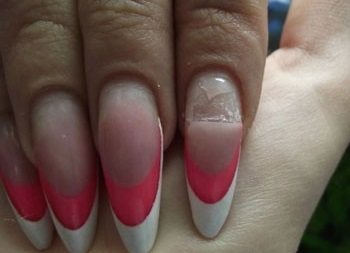
Peeled nail extensions
Peeling often occurs in those who do their own nails - due to carelessness and inconvenience in applying the material.
Even experienced professionals may try to save time by skipping some steps of the procedure, which leads to chipping and peeling of the gel. It is better to visit a trusted specialist or learn how to do quality extensions at home.
Technical reasons for peeling nails
- Incorrect nail modeling,
- applying the finishing coat in a thick layer,
Compliance with all extension technologies is the key to flawless extended nails
air bubbles getting under the material, poor preparation of the nail, insufficient polishing, the presence of particles of the old coating in the cuticle area, lack of antibacterial treatment of the nail plates, the master did not create a stiffener, forgot about the primer, bond, degreaser, the gel was applied to a non-dried surface.
Compliance with nail extension technology is an important factor in avoiding manicure delamination. Watch the video master class on gel nail extensions from a professional master:
What is the difference between single-phase and three-phase gel
The sequence of step-by-step actions for gel nail extensions on forms differs depending on what technology is used: single-phase, two-phase or three-phase.
Differences:
- The gel composition used for single-phase extensions performs all the necessary functions: it guarantees adhesion to the nail base, allows you to model the required contours of the nail, and ensures the smoothness and shine of the coating. This technology is very convenient for beginners, because... the easiest to use: only one type of gel is required, which is applied in one step and fixed in one session of irradiation with an ultraviolet lamp.
- Two-phase technology requires the use of two types of gel. One of them provides connection and modeling, and the second is protective, ensuring smoothness and strength of the nail. Accordingly, two layers are required and two curing sessions under a UV lamp are required.
- Working with three-phase technology is the most time-consuming. Three compounds are used: for adhesion, for modeling, for protection. Each layer is applied and irradiated with a lamp separately. This method requires the master to have work experience and qualifications. Professionals prefer this technology due to the high quality of modeling.
Ways to solve the problem
The right solution to prevent manicure deformation is proper care. Do not forget that before the procedure, manicure should not be done for about four days.
After the extension procedure has been carried out, you should not engage in self-correction; a timely visit to the specialist for this work is mandatory. Do not ignore the recommendations of the salon employee who performed the work. Proper care and following the master's recommendations are the key to ensuring that your manicure will last a long time.
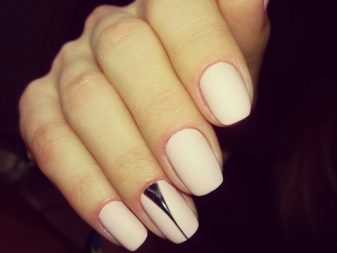
Beautiful, long nails that look well-groomed are not only a luxury, but also a necessity. A well-done manicure will save time and always look amazing. Do not be afraid to extend your nails with gel for fear that they may quickly break or peel off. Choose a good master, don’t skimp on your beauty and take proper care of your nails, and then everyone will be the envy of your hands.
The attached video lists the reasons that lead to damage to extended nails.
Why do extended nails turn out flat?
A beautifully executed manicure can decorate any woman, giving her image well-groomed and sophistication. Nails with a hump do not look natural, so when applying extensions, you must ensure that the gel lies evenly on the plates.
Why do nails end up with a hump during extensions and how can you avoid this? After all, women come to the salon to beautify themselves and it is important that everything is done at the highest level. It is common that representatives of the fair sex naturally have crooked nails
The reasons for this phenomenon are varied. Among the most basic are:
It happens that representatives of the fair sex naturally have crooked nails. The reasons for this phenomenon are varied. Among the most basic are:
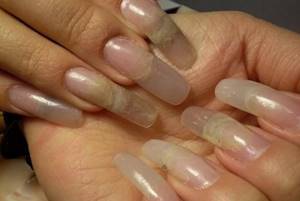
- changes in the level of hormones in the blood;
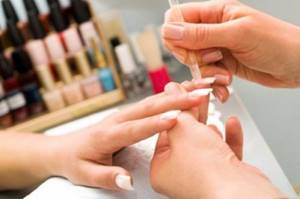
- poorly executed manicure.
The first five reasons do not depend on the master. To eliminate them, a woman must take care of her health and hygiene. Injured and fungal nails, for example, can only be cured over time. After a few months, the old plate will completely peel off and a new one will grow. During the treatment period, it is recommended to apply special ointments to the nails and refuse manicures, much less extensions. It is permissible to use only medicinal gel.
If the cause of the appearance of a hump on the plates is vitamin deficiency, you need to adjust your diet. This phenomenon is often observed in the spring, when the body is exhausted. It is not recommended to coat damaged plates with gel. If it is impossible to refuse the procedure, you need to talk to the specialist. An experienced professional knows how to give your nails a well-groomed look and perfect smoothness. There are techniques that help deal with unevenness. For example, thickenings and bumps can be cut down. Before applying the coating to the nails, the master always sands the surface of the nails. If there is a defect, you can pay special attention to the bulges and simply remove them mechanically. There are special bases designed for leveling nail plates. A competent master always uses such products before applying colored gel or acrylic.
A hump on the plates can also appear as a result of improperly performed extensions. There are different reasons. The most important ones are the use of low-quality material and insufficient qualifications of the craftsman. Nail gel should have a normal shelf life and not be too thick. If the material is very thick, it will not be possible to apply it evenly. Unsightly humps will most likely form on your nails. It will be more difficult to correct the defect after modeling, but you can try to cut off the high spots and then paint the plate with another layer of gel.
If the qualifications of the master are not very high, the likelihood of an error when performing a manicure is high. It is in the process of learning the art of extensions that nails with a hump are most often obtained.
It is very important to choose the right specialist. Nails with a hump can also result if the rules for drying the gel are not followed.
After applying the material to the plate, you need to place your hands on the table for a while so that your fingers are parallel to the horizontal surface. In the same position, the drying procedure should be carried out under a lamp. If you dry your nails vertically, with your hands down or up, gel streaks may form on the plates, which will look like humps. You can get rid of them only by cutting them down.
Nails with a hump do not look very neat. To ensure a perfect manicure, you should monitor the condition of the nail plates, and when applying extensions, use the services of trusted professionals, and also avoid purchasing low-quality materials.
Main problems
So, you have finally decided to get your nails done. If the master strictly adheres to all stages of the procedure, uses only high-quality materials and is meticulous about his own work, the risk of problems is minimal.
The consequences of the extension procedure can be:
- allergy. Regardless of the material chosen, it can appear immediately after extensions, several months or even years later. Individual intolerance can be recognized by several signs. The skin around the plate turns red or blue, dries out, and peels. The fingers may become swollen and small blisters may appear that burst and bleed. In addition to the local reaction, severe runny nose, swelling, itching and, very rarely, redness of the eyes may appear;
- fungus. Symptoms depend on the type of fungus. Most often, women note the appearance of yellow spots or grooves on the plate. The nail fold turns red, swells and thickens, and the skin is very itchy. Silvery scales appear on the sides of the nail bed. If an infection joins the fungus, suppuration appears; Violation of the nail structure
- mold on nails. Unscrupulous work by a craftsman can lead to peeling of the artificial material and the natural plate. Moisture accumulates in the resulting space, which provokes the development of mold. The causes of the disease may be a weakened immune system, infection of the plate, constant contact of hands with water, cleaning agents and high temperatures;
- violation of the nail structure. The plate may change color, grooves and waves appear, the nails become very thin and brittle and stop growing.
Sometimes girls complain that their nails hurt after extensions. The appearance of unpleasant sensations also indicates the unprofessional work of the master.
On a note! Fashion ideas: nails 2018
Causes of premature detachment of extended nails
Sometimes the answer to the question of how long nail extensions last can be completely ambiguous. This can be purely individual. If you suddenly notice that peeling has appeared on your nails or their shine has completely faded, and very little time has passed since a fresh overlay, then sound the alarm and immediately visit your master.
Causes:
- a mistake made by the master because he incorrectly calculated the architecture of the applied nail;
- the tip is sanded unevenly or the coating is applied very carelessly;
- inflammation of the skin, due to which the applied plate becomes foreign, and a process of rejection occurs;
- fungal disease or the presence of other body disorders;
- medications that interact poorly with foreign bodies;
- your own manicure, which was performed before the extension procedure and was not removed properly;
- hormonal status (nail extensions cannot be done during the menstrual cycle, pregnancy and the early postpartum period).
Reasons for chipping of gel-based coating on the tips
The causes of chipped ends most often lie in poor technique and improper care:
- The layer is not sealed at the end. Some masters are guilty of this, especially when they work with short lengths. If you don't paint the end, the coating will probably start to chip.
- Sometimes clients apply the layer themselves when they adjust their clothes, pick up the phone, or put their hand under a lamp.
- Improper care after the procedure makes the manicure short-lived. It is better to avoid water for several hours before and after the procedure, but many girls neglect this.
- Gel polish is a fairly durable material, but it cannot withstand severe or frequent mechanical damage. Impacts or scratches damage the integrity of the coating.
- You cannot adjust the length or file the nail yourself, otherwise the coating may crack.
- Thin nails will probably break off under gel polish, thereby causing chips.
Additional decor of extended nails
Unlike short nails, extended nails allow you to create incredibly beautiful designs and entire paintings. Therefore, one of the most popular is graphic manicure. That is, various kinds of abstract drawings
They look great on nails and draw attention to the hands.
Bright, stylish manicure using the shading technique and a beautiful, elegant abstract design.

Mini-landscapes on marigolds look no less fascinating
But in this option, it is very important to find a nail artist who is really good at drawing and can create something very beautiful. For example, lush greenery, various marine motifs or floral designs
To create a festive version of the manicure, you can use additional decor in the form of rhinestones, special powder, lace and even small shells.

The delicate shade on the nails looks very harmonious in combination with powder and rhinestones that are correctly matched to the tone.

Stylish, sophisticated manicure design is made using adhesive tape and different shades of varnish.
French and lunar manicure is not losing ground. This classic is immortal and will always be especially popular. As for colors, in 2022, to create such a manicure, you can use not only the classic combination, but also add some variety. For example, red and black or white and black look great on extended nails.
An incredibly beautiful French manicure in a soft pink shade is complemented by additional decor in the form of flowers in a contrasting color.
An interesting option for a dot design on extended nails.
A rather unusual execution of French manicure due to correctly positioned lines.
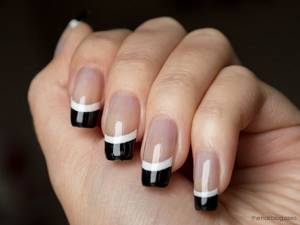
French manicure does not have to be done in the classic version. Imagine, use your imagination and always try something new.
Of course, not every girl can make beautiful designs. And if you are one of them, then just use the slider design. With its help, you can create a simply stunning drawing without spending much time on it. It is enough just to wet the pre-prepared picture with water and transfer it to the nail. And of course, in order for the design to last as long as possible, you need to cover it with a transparent varnish or topcoat.
To create a truly interesting and unique design, use several decor options. For example, the photo combines several types of varnish, special powder, slider design and rhinestones
But it is very important that everything together looks stylish and not too bulky

An equally well-known way to create an irresistible design for extended nails is stamping. This is also a fairly popular technique, for which you will need a stamp, stencil, and high-quality varnish. Try transferring the design onto paper several times, after which you can experiment on your nails. Believe me, the result will definitely surprise you.
Of course, if you draw beautifully, you can make the design yourself. Many girls make simply amazing drawings. Thus showing originality and your own sense of taste and style.
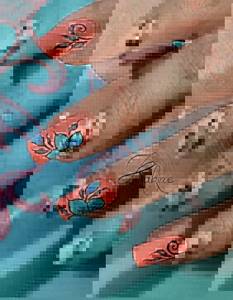
Some design options may not be to everyone's liking. But on the other hand, the design on the nails is a vision or feeling of the world of a certain person. So why not experiment?
Delicate, romantic design for delicate and graceful natures.
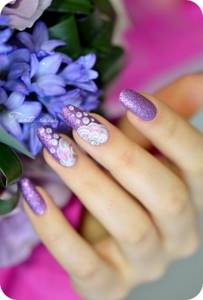
Perhaps someone will say that extended nails have long been out of fashion and doing them is bad manners. These words are partly justified. But on the other hand, 2022 allows you to show individuality, creativity and your own style. So why not try getting your nails done again? After all, it is their length that allows you to create and draw truly amazing drawings and even whole paintings. How do you feel about extended nails? Do you often resort to this type of manicure?
Treatment
A dermatologist treats pathology. This specialist, based on one appearance and the result of an analysis of microflora, can determine why this happened and suggest the optimal treatment regimen. The approach to treatment is always comprehensive. First, the cause that caused onycholysis is eliminated. If these are diseases, then they should be treated. If it's a matter of frequent manicures, you need to give your nails a rest and not paint them or expose them to UV radiation for a while.
The exfoliated part with partial damage must be regularly trimmed and treated with antiseptics. It is advisable to protect the injured nail plate with a bactericidal plaster. If the detachment is large in area, surgical treatment involving removal of the nail plate and cleaning of the bed will be used. After this, apply a sterile bandage.
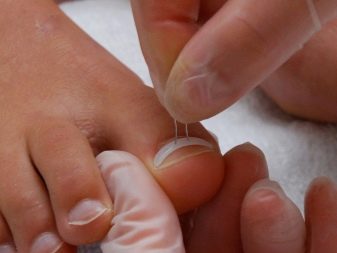
During the entire course of treatment, a woman is prohibited from contacting the damaged nail plate with water, manicure products, varnishes and any household chemicals. If there is a need to wash dishes, you need to do this with special durable rubber gloves; while bathing in the shower or bath, you need to isolate the diseased nail with a bactericidal plaster.
